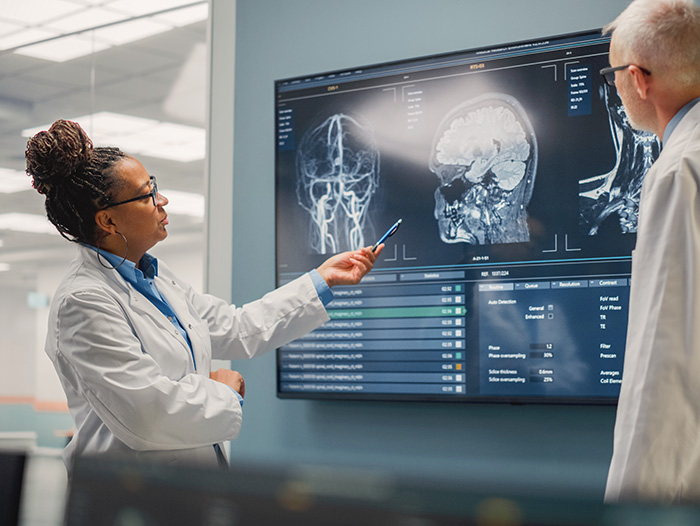During the pandemic, remote patient monitoring (RPM) saw a significant surge in popularity. However, regulations have not kept up with the service's outsized growth. To help health systems use the technology responsibly, Advisory Board's Lauren Woodrow outlines three things leaders should consider when evaluating their RPM programs.
RPM booms in popularity
In 2019, Medicare made it easier for providers to bill for remotely monitoring routine vital signs, such as blood pressure, weight, and blood sugar. Previously, coverage for RPM was limited to certain patients, such as those with pacemakers.
Medicare also began allowing physicians to be paid for RPM even when it was performed by clinical staff working in different places than the physician — a change that telemedicine companies advocated for.
Between 2019 and 2021, the number of RPM services billed to Medicare saw a significant jump, going from fewer than 134,000 to 2.4 million. Total Medicare payments for the four most common RPM billing codes also increased from $5.5 million in 2019 to $101.4 million in 2021. Similarly, the number of providers who repeatedly billed for RPM increased from around 400 in 2019 to around 3,700 in 2021.
"The patient need is so enormous," said Chris Altchek, CEO of the RPM company Cadence. Currently, around two-thirds of Medicare beneficiaries have high blood pressure, which is the most common metric tracked by RPM.
According to Denton Shanks, a physician at the University of Kansas Health System and a medical director at the American Academy of Family Physicians, RPM helps patients manage their health conditions and allows physician practices to be more efficient.
"For the vast majority of patients, once they are enrolled, they see a benefit, and we see a benefit as their vital signs come in the normal range," Shanks said.
Providers who are not paid by Medicare to offer RPM services have also seen benefits. For example, Frederick Health pays for the RPM program itself and does not bill Medicare. Lisa Hogan, who runs Frederick's RPM program, said RPM has helped the health system save $10 million a year by reducing hospital admissions and ED visits.
Is lack of oversight leading to a 'wild West'?
As use of RPM continues to grow, some experts have expressed concerns about a lack of oversight and limited research on the best way to use the technology.
"It is the wild West where any patient can get it if a doctor decides it is reasonable and necessary," said Caroline Reignley, a partner at the law firm McDermott Will & Emery who advises health providers.
Currently, there are a few small studies that suggest RPM can improve patient outcomes, but researchers say it's unclear which patients see the most benefit or how long they need to be monitored.
"The research evidence is not as robust as we would like to show that it is beneficial," said Ateev Mehrotra, a researcher at Harvard Medical School.
In January, the Bipartisan Policy Center released a report saying that there was a "lack of robust evidence on the optimal use of remote monitoring" and that some policy and medical experts "question whether we are effectively 'rightsizing' the use of these services, ensuring access for patients who need it most, and spending health care dollars in effective ways."
There have also been concerns about fraudulent RPM companies and services. Currently, federal law enforcement officials are investigating RPM-related complaints, including that some companies are signing up Medicare patients for the service without their physicians' knowledge or that they're billing Medicare for RPM services even when no monitoring happens.
According to Meena Seshamani, director of CMS' Center for Medicare, the agency is working to balance the need to provide patients with access to emerging technologies with the need to combat fraud and properly pay providers for their services. (Taylor, Becker's Clinical Leadership, 3/18; Galewitz/Hacker, KFF Health News, 3/18)
3 steps to improving patient care through RPM
RPM is not a new technology, but it has boomed in utilization in recent years due to the COVID-19 pandemic — and understandably so. RPM gives us the ability to tailor the intensity and nature of care to patients in a more effective way, which has a positive impact on clinical decision-making.
However, the huge uptick in vendor offerings and care applications has surpassed existing regulations and guidelines. Until regulations can catch up, it falls to health systems to responsibly deploy RPM solutions. Providing RPM devices without broader organizational guidance could result in access going only to those who:
- Have the digital and health literacy to ask for remote monitoring options
- Can afford to pay out of pocket for the technology
To ensure effective use of healthcare dollars and strides toward equitable patient access, it is important to establish standardized deployment criteria across an organization. While principled access to RPM will vary between organizations — and potentially service lines — health system leaders should consider three things when evaluating clinical access:
1. Referral patterns: Examine which types of patients are currently enrolled in your RPM programs and how they were enrolled. If there are high percentages of self-referrals, it could be a sign that communication and patient identification strategies need to be strengthened to expand access to those with lower levels of health and digital literacy.
2. Technology usability: Determine how easily patients and caregivers can access resources for RPM platforms and devices. Some sample resources include who to contact with questions about the tech (is it the provider or an RPM vendor?) and how to upload data to the platform if it's self-reported rather than automatic. A lack of understanding on how to properly use the RPM technology could result in lower adherence rates and potential disenrollment.
3. Organizational buy-in: Demonstrate trust in RPM applications and find clinician champions who can drive RPM uptake. A successful RPM program depends on effective and regular communication between clinicians and strategy/operations, and clinicians and patients. Finding clinician champions who are proactively identifying and engaging patients for RPM programs is essential to improving access.
Ultimately, understanding your patient population is necessary to ensure equitable access to RPM technology. Rather than maximizing the number of patients using RPM, be thoughtful about the number of patients in each program to ensure the "right" patient is gaining access.
Don't miss out on the latest Advisory Board insights
Create your free account to access 2 resources each month, including the latest research and webinars.
Want access without creating an account?
You have 2 free members-only resources remaining this month remaining this month.
1 free members-only resources remaining this month
1 free members-only resources remaining this month
You've reached your limit of free monthly insights
Become a member to access all of Advisory Board's resources, events, and experts
Never miss out on the latest innovative health care content tailored to you.
Benefits include:
You've reached your limit of free monthly insights






